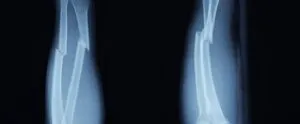Neck Injury Attorney
Need an attorney who will work tirelessly to secure the maximum settlement for your neck injury claim?
The neck is a crucial part of the body that is often underappreciated, especially considering all of the important work that it does for your body. Beyond supporting and balancing your head, the neck provides the critical passageways for food, air, blood, and nerve signals to pass between your head and the rest of your body. An injury to this important part of the body could interrupt any one of those functions and could have long-lasting, devastating effects on you and your family. One slip and fall could mean the difference between having full mobility of all of your limbs and spending your life in a wheelchair, dependent on nearly round-the-clock care to function. Read on to learn more about neck injuries, including what you could do if someone caused you to suffer one.
Calling My Rights Law Injury Lawyers Makes Sense
The serious injuries lawyers at My Rights Law are dedicated to helping neck injury victims get the best resolutions to their situations. In your consultation, we will prudently evaluate your case and advise you on your options. We will fight on your behalf to get you paid. Most cases are taken on a contingency fee basis. This means that attorney’s fees are not due unless you prevail against the responsible party. You do not want to hire just any law firm or any personal injury attorneys for legal representation. Consider the personal injury lawyers at My Rights Law who will hold your wrongdoer accountable and make them pay you for the harm that they have caused. To request a free consultation with the legal team at My Rights Law, call (888) 702-8845 or leave us a message on our secure web form.
- 1. The Neck Structure
- 2. Bones Of The Neck
- 3. Spinal Discs
- 4. Nerves
- 5. The Trachea And Esophagus
- 6. Muscles And Ligaments
- 7. What Are The Common Neck Injuries?
- 8. What Is Whiplash?
- 9. Neck Care And Maintenance
- 10. Mind Your Posture.
- 11. Adjust Your Living And Workspaces.
- 12. Stretch And Strengthen Your Neck Muscles.
- 13. Neck Injury Lawsuits
- 14. Time To File Your Legal Claim
- 15. Types Of Compensation That May Be Available
- 16. Finding Fault
- 17. Hiring A Neck Injury Attorney
The Neck Structure
The neck is a crucial part of the body that is often underappreciated, especially considering all of the important work that it does for your body. Beyond supporting and balancing your head, it provides the pathway that allows your brain to communicate with the rest of your body and holds structures essential for breathing, eating, and drinking.
When all of the parts of the neck are working together properly, you probably don’t give it much thought. If any part of the system is injured or overstrained, though, you may become acutely aware of it as you deal with pain, stiffness, or other issues affecting its important structures.
Bones Of The Neck
The neck bones, called the cervical spine, have the most mobility of all of the areas of your spine. The bones and muscles of the neck are designed to move the head up and down, turn the head to the left and right, tilt the head to one side or the other, and perform combinations of these directional moves.
The cervical spine is made up of seven individual bones called vertebrae (singular, vertebra). The two top vertebrae are unique and are shaped differently than the other bones of the spine. These two bones hold up the head and give it a wide range of motion.
Spinal Discs
As in the rest of the spine, a semi-soft disc rests in between each pair of vertebrae to support and cushion the bones. These discs are often compared to a jelly donut due to their ring-like shape that is semi-solid on the outside and gelatinous on the inside. The gel helps to act as a shock absorber between the bones.
Because of an injury, the discs of the cervical spine can become stiffer and less flexible, leading to degenerative changes that can contribute to neck injuries. The discs can be injured or damaged by trauma to the neck area or even by strain and pressure caused by poor posture over time. Since the discs receive no blood flow, the cervical discs cannot repair themselves like other tissues in the body can.
Nerves
Like the vertebrae that comprise the rest of the spine, the cervical vertebrae have spaces built into their sides that let nerves exit the spinal column to reach other parts of the body. These nerves send critical information between parts of your body and your brain, allowing you to feel sensations and control your muscles.
The Trachea And Esophagus
Other important parts of your body pass through your neck as well. The trachea connects the nose and mouth to the lungs to allow you to breathe air in and out. The top of the trachea also includes your vocal cords, which use the air passing through the trachea to make sounds and allow you to speak. The esophagus is another critical structure in the neck. It is the canal that transports food from your mouth to your stomach.
Muscles And Ligaments
Working together with all of these critical parts of your body are the muscles and ligaments that help to hold it all in place and let you move your neck and head around. Ligaments are thin, strong fibers that connect bones to muscles, and the muscles are the tissues that get signals from your brain to move.
What Are The Common Neck Injuries?
With all of their internal complexities, neck injuries can range from annoying and painful to very severe and potentially life-threatening. The most common causes of neck pain are:
- Whiplash from the force of a car accident
- Strain from poor posture, whether sitting or standing
- Disc degeneration that can lead to nerve compression
- Infections such as meningitis
- Inflammation of the joints, or arthritis
- Stress or impact involved in some sports activities
Neck injuries can require different types of treatment to help solve or alleviate the pain. There is no one-size-fits-all solution.
What Is Whiplash?
When you are involved in a car crash, the forces of the impact often put huge pressure on the muscles of the neck. A rear-end collision, especially, can cause your head to snap backward and forward as the momentum of the impact transfers from the car to your body. Safety features in your car, such as seat belts and airbags, are important for keeping you safe, but they don’t do much to stop your head from being snapped forward and backward or side-to-side in a side-impact crash.
Whiplash causes strain to the soft tissues of the neck, including the ligaments and muscles that help to support the bones. The joints adjoining the vertebrae and the discs that cushion the bones can be damaged by the force of whiplash. In the most severe of cases, the spinal cord itself could be damaged, which could lead to permanent paralysis of the legs and arms.
Symptoms may start immediately after the crash, or they may come on in the days following the impact. You may feel neck pain and stiffness or burning or tingling sensations, or you might experience headaches and dizziness. Medical providers might prescribe pain medications and muscle relaxants to help, and they may have you wear a cervical collar to support your head and take the pressure off of your neck muscles while the area heals. Treatments for whiplash can include physical therapy, exercises and stretches, and the application of heat or ice to relieve muscle tension and pain.
Neck Care And Maintenance
There are several measures you can take to maintain good neck health and try to prevent future injury or to facilitate recovery from an existing injury. These may include:
Mind Your Posture.
The neck supports the weight of your head, which averages 10 to 12 pounds, about as much as a bowling ball. Poor posture that puts unnecessary strain on the muscles and ligaments of the neck can lead to pain and stiffness. While standing, be sure to keep your head straight above your shoulders, not drooping forward. Sitting at a desk and working on a computer that isn’t at the right height can cause you to tilt your head forward too much, causing strain. Even spending too much time browsing on your smartphone or tablet can lead to neck strain as you are leaning forward to see the screen in your hands. Slouching can also curve your neck in a way that can injure your muscles.
Adjust Your Living And Workspaces.
Ergonomics is the science and study of ensuring the correct alignment of your body in your workplace or home environment. You may be able to avoid injury to your neck by making a few modifications to your home or office. These may include proper set-up of your office chair and computer or adjustments to places where you relax at home, like the couch you sit on when watching TV or even your bed.
Stretch And Strengthen Your Neck Muscles.
To maintain good neck health and guard against future injury, you can engage in some exercises and stretches aimed at strengthening your neck muscles. You may want to consult with a physical therapist or even a personal trainer to make sure the exercises that you are doing are helpful rather than harmful to your neck.
If you have a neck injury and go to physical therapy, the therapist may provide you with special stretches and exercises to do to help with your recovery. When you’re dealing with neck pain from an injury or strain, you should be aware that some exercises and activities outside of those taught to you by your physical therapist can cause more problems for your neck. Weightlifting, for example, can put a strain on the complex muscles that work together to support your head and neck. It may be a good idea to speak with your physical therapist about the other exercises you are doing to make sure that they won’t disrupt any progress in your recovery.
If you’ve had a neck injury or feel like you may be developing problems with your neck that cause pain or stiffness, consult with your medical provider. In most cases, you can learn what is causing the problem and understand ways that you can change some activities to avoid further damage to the critical structures of your neck.
Neck Injury Lawsuits
When you have suffered a neck injury, you may be able to get help with paying the medical bills and be compensated for the pain and trouble you’ve gone through because of the injury. An accident that was caused by someone else that left you suffering from an injury is unjust, and the law can help you to get justice. Lawyers who are experienced in neck injury cases know how to get a settlement or court verdict that compensates you for your losses.
Time To File Your Legal Claim
It is important to remember that there are time limits on your right to file a lawsuit based on your claim. This law, often called a “statute of limitations,” typically gives you a short period to bring a case in court from the date of the incident that caused the injury. Once you or your lawyer has filed the papers to officially start the lawsuit, the process can go on from there, but if you are a day too late in filing the original complaint to start the case, you may lose your right to take the case to court. It is critically important to talk to a lawyer about your claim and understand your legal rights.
Types Of Compensation That May Be Available
The law helps you to deal with the consequences of an accident that has left you injured by getting you money to pay medical bills and to help you get back to your life in the best way possible. The money that the law allows for your injury is called “damages,” and it comes in a few main types in the law.
Most personal injury cases deal with two types of damages, which are called economic and non-economic damages. The amounts that add up to the economic or “special” damages total are basically the things that have a dollar value, like medical expenses and compensation for lost wages. Non-economic or “general” damages include things that you’ve had to deal with emotionally and personally, and they are usually called “pain and suffering” damages.
Finding Fault
In some states, the law allows the court to compare all the factors that went into causing the accident and divide out the percentages of fault to each person who was involved in it. Dividing out or “allocating” the fault for the accident can be simple, if one person was driving recklessly and caused the crash, for example.
The calculation can be more complicated if two or more drivers were each making mistakes or acting negligently, because then the law assigns a portion of the blame to them, such as 65% fault to the defendant for making an illegal turn and 25% fault to a second defendant who swerved dangerously into your lane, and 10% to you for traveling faster than the speed limit when these things happened that caused the crash, as an example. Understanding your rights and how to make your claim is critical to getting justice, and a lawyer is your best guide to the process.
Hiring A Neck Injury Attorney
If you suffered a neck injury on the job or feel that your neck injury was caused by someone’s negligence, you may want to consult with an experienced personal injury attorney to determine your legal options. You might qualify for workers’ compensation or disability insurance coverage if the issue is job-related. Alternatively, if someone’s negligence caused your injury, then you might be able to pursue legal action against them to recover compensation for things like the cost of your medical bills, lost wages, and pain and suffering. Keep in mind that you generally only have a limited time from the date of your neck injury to file a lawsuit, so don’t sleep on your rights.











